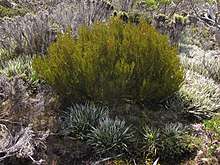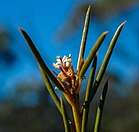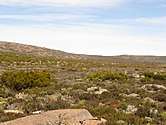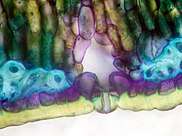Orites acicularis
Orites acicularis, commonly known as yellow bush, is an angiosperm endemic to Tasmania, Australia and is a member of the genus Orites within the family Proteaceae. The species was first described in 1810 by Scottish botanist Robert Brown in Transactions of the Linnean Society of London.[1]
| Orites acicularis | |
|---|---|
 | |
| Orites acicularis in sub-alpine habitat on Mount Wellington, Tasmania. | |
| Scientific classification | |
| Kingdom: | Plantae |
| Clade: | Tracheophytes |
| Clade: | Angiosperms |
| Clade: | Eudicots |
| Order: | Proteales |
| Family: | Proteaceae |
| Genus: | Orites |
| Species: | O. acicularis |
| Binomial name | |
| Orites acicularis (R.Br.) Roem. & Schult. | |
| Synonyms | |
| |
Description
Orites acicularis is a yellow-green coloured, woody, rounded shrub growing to approximately 1–1.5 m (3.28–4.92 ft) in height and 0.5–1 m (1.64–3.28 ft) in width, with many ascending branches.[2]
The leaves are of a conspicuous yellow-green colour; they are glabrous, sclerophyllous, approximately 10-35mm long, and rounded.[3] They taper to a sharp point, which is typically more yellow than the rest of the leaf. The adaxial surface of the leaf has a shallow central groove,[4] and the leaf margins are entire. Leaves attach to the woody stem by a 2–5 mm petiole.[3]
Flowering occurs in December, and presents upon a rachis which can be terminal or axillary. The perianth is homochlamydeous; it comprises four white-cream tepals with a groove running along the centre, and curling under to display the pink style.[3] The immature fruit is a green similar to that of the leaves. The fruits are glabrous and oblong, with a elongated tip of reddish brown. When mature, the follicle is lignified and erect, approximately 15 mm long, and boat-shaped.[3] The boat shape is due to the seeds having been released immediately upon maturity.[2][3]
Habitat and distribution
Orites acicularis commonly occurs in Tasmanian sub-alpine mountain plateaus, heaths, and boulder fields with a geology of dolerite, granite, and diorite.[3] Dolerite's slow rate of erosion results in shallow, low-nutrient soils with an abundance of rock fragments. In sub-alpine plateaus, depressions form in the boulder fields. There, vegetable and mineral matter accumulate, creating bogs or smaller areas of deep soil. Similarly, bolster heath impedes drainage, creating shallow peats.[5]
Other species of plants that commonly grow in this habitat include: Gleichenia alpina, Astelia alpina, Baeckea gunniana, Bauera rubioides, Orites revoluta, Richea sprengelioides, Tasmannia lanceolata, and Eucalyptus coccifera.
Adaptations to solar radiation
Orites acicularis has evolved a number of characteristics to assist with protection from solar radiation in excess of its photosynthetic requirements. Two such adaptations are its abaxial pseudohypodermis and its bundle sheath extensions.[6]
Bundle sheath extensions are formed when sclerenchyma and/or collenchyma cells around a bundle sheath extend to both the adaxial and abaxial epidermis layers of a leaf.[7] The evolution of these bundle sheath extensions in species restricted to open vegetation in the family Proteaceae suggests that it is a recurring adaptation to provide protection against the high levels of solar radiation present.[6] The Orites-type abaxial pseudohypodermis is defined as multiseriate, elongate sclerids forming a reticulum around the sub-stomatal cavities (Jordan et al. 2005) and acts as a further barrier to solar radiation that lies just below the cuticle of the plant.[6]
Etymology
The specific epithet, acicularis, is derived from Latin and means "needle-shaped".[8]
References
- "Vascular Plants APNI – Australian Plant Name Index". Biodiversity. Retrieved 2018-03-11.
- Howells, Christine (2012). Tasmania's Natural Flora (2nd ed.). Hobart: Australian Plants Society Tasmania. ISBN 978-0-909830-66-3. OCLC 803605684.
- "ABRS Flora of Australia Online Search Results". anbg.gov.au. Archived from the original on 2018-03-16. Retrieved 2018-03-05.
- Jordan, Greg. "Key to Tasmanian Vascular Plants". utas.edu.au. Retrieved 2018-03-11.
- Crowden, R. K. (2005). "Alpine Vegetation". Vegetation of Tasmania. Canberra: Australian Biological Resources Study. pp. 333–56. ISBN 978-0-646-44512-0.
- Jordan, Gregory J.; Dillon, Rebecca A.; Weston, Peter H. (May 2005). "Solar radiation as a factor in the evolution of scleromorphic leaf anatomy in proteaceae" (PDF). American Journal of Botany. 92 (5): 789–796. doi:10.3732/ajb.92.5.789 – via Research Gate.
- Raven, Peter H.; Evert, Ray F.; Eichhorn, Susan E. (2005). Biology of Plants. New York: W.H. Freeman and Company Publishers. pp. 566. ISBN 0-7167-1007-2.
- Eggli, Urs; Newton, Leonard E. (2004). Etymological Dictionary of Succulent Plant Names. Berlin, Heidelberg: Springer. p. 1. ISBN 978-3-540-00489-9. Retrieved 14 November 2018.





